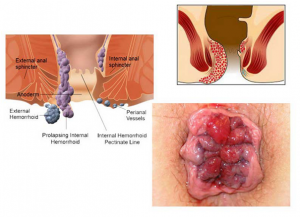OVERVIEW
Hemorrhoids, also known as pile, similar to varicose veins are swollen veins in the lower part of the anus and rectum. Mostly, during defecation the walls of these blood vessels stretch so thin that it bulge and get irritated. In its normal state, they are vascular structures in the anal canal that help with stool control. Swollen hemorrhoids or piles is also known as hemorrhoidal disease. They are rarely dangerous and usually clear up in a couple of weeks.
TYPES OF HEMORRHOIDS
internal hemorrhoids and external hemorrhoids.
- Internal hemorrhoids – usually, this type of hemorrhoids lies inside the rectum and you can’t see or feel it. They are normally painless. The first sign that internal hemorrhoids are present is rectal breeding.
- External hemorrhoids – this type of hemorrhoids are under the skin around the anus, where there are present of more pain-sensing nerves. It causes discomfort and pain. They are visible and straightening, when passing a stool may cause them to bleed.
SIGNS AND SYMPTOMS
Signs and symptoms of hemorrhoids may include;
- pain and discomfort or soreness in the affected area
- painless bleeding
- lumps and swelling in the anal region
- itching or irritation in the anal area
- leaking feces
- pain during bowel movements
- painful lumps around the anus
CAUSES
There are several conditions and habits thought to cause hemorrhoids, they include;
*Anal intercourse
*low-fibre diet
*obesity
*chronic diarrhoea or constipation
*pregnancy
*straining during bowel movements
*sitting on the toilet for a long time
*Aging
DIAGNOSIS
your physician may be able to see if you have external hemorrhoids simply by looking. There are procedures to diagnose internal hemorrhoids which include;
Visual inspection– the doctor examines the lower portion of your colon and rectum with anoscope, sigmoidoscope or proctoscope.
Digital examination – your doctor inserts a gloved, lubricated finger into your rectum. If your doctors feels something unusual, there will be need for further testing.
TREATMENT
There are categories of hemorrhoids treatments. These include; pharmacological, non pharmacological(home remedy), and surgical procedures.
Non pharmacological procedures ( home remedy)
-whole high-fibre foods – eat more fruits, whole grains and vegetables
-soak your anal area in plain warm water two to three times a day.
-keep the anal area clean.
-Apply ice packs on your anus to relieve swelling.
-Don’t use dry toilet Paper.
Pharmacological treatment -If your hemorrhoids produce only discomfort,your doctor may advise you to apply (OTC) over the counter hemorrhoids creams to the affected area.
Surgical procedures
Surgical procedures will be advised if you have a large hemorrhoids or if other procedures haven’t been successful. Surgically hemorrhoids can be removed in the following ways.
-Hemorrhoidectomy–surgical removal of hemorrhoids.
-Hemorrhoids stapling- This procedure blocks blood flow to hemorrhoidal tissue.
COMPLICATIONS
Anemia – bleeding from chromic hemorrhoids can cause anemia.
strangulated hemorrhoid – strangulated hemorrhoids occurs as a result of lack of oxygen supply to the prolapsed hemorrhoids.


